Philip Woodward facts for kids
Quick facts for kids
Philip M. Woodward
|
|
|---|---|

Woodward with W5 at the British Horological Institute
|
|
| Born | 6 September 1919 |
| Died | 30 January 2018 (aged 98) |
| Alma mater | Oxford University |
| Known for | Ambiguity function, sinc function, rect function, comb operator, rep operator, ALGOL 68-R |
| Awards | Lifetime achievement award of the Royal Academy of Engineering (2005) IEEE Dennis J. Picard Medal for Radar Technologies and Applications (2009) Tompion medal of the Worshipful Company of Clockmakers (2009) |
| Scientific career | |
| Fields | Signal processing, computing, horology |
| Institutions | Telecommunications Research Establishment, Royal Signals and Radar Establishment |
| Influences | Harold Jeffreys, Claude Shannon |
Philip Mayne Woodward (born September 6, 1919 – died January 30, 2018) was a brilliant British scientist. He was a mathematician, a radar engineer, and an expert in horology (the study of time and clocks). He was very successful in all these areas. Before he retired, he worked for the British Ministry of Defence. He was a deputy chief scientific officer at the Royal Signals and Radar Establishment. This place was in Malvern, Worcestershire, England.
Contents
Philip Woodward's Work in Science
Philip Woodward worked for the British government's science department for 40 years. He helped create the software for some of the UK's first electronic computers. These included the TRE Automatic Computer (TREAC). He also worked on the UK's first solid-state computer.
During World War II, Woodward developed a special math technique for radar. This technique helped shape radar beams. It later became a standard way to analyze communication signals. His main achievement in radar was understanding how radar signals can be unclear. He showed how to use Bayesian probability to get only the information you want from radar echoes.
In 1956, a Nobel Prize winner named John Hasbrouck Van Vleck invited Woodward to teach at Harvard University. This was because of Woodward's work on radar and information theory. Another professor, Edwin Thompson Jaynes, said Woodward was "many years ahead of his time." He praised Woodward's "prophetic insight" into using probability to get data from noisy signals.
In the 1960s, Woodward's team created the ALGOL 68-R compiler. This was the first time the ALGOL 68 programming language was used. His team also gave the armed forces their first standard high-level programming language, CORAL 66. This was for the smaller military computers of that time.
Woodward also taught at universities. He was an honorary professor at the University of Birmingham. He was also a visiting professor at the University of Reading. In 2000, a building was named after him at the Defence Evaluation and Research Agency. Guests at the opening received clocks as gifts. This was a nod to Woodward's love for clocks.
In 2005, the Royal Academy of Engineering gave Woodward its first Lifetime Achievement Award. This award recognized him as a pioneer in radar. It also honored his work in making very precise mechanical clocks. In 2009, he received another award, the IEEE Dennis J. Picard Medal for Radar Technologies and Applications. This was for his important work in designing radar signals. This work included the "Woodward ambiguity function," which is a key tool for radar analysis.
Philip Woodward's Clocks
After retiring, Woodward wrote another book called My Own Right Time, or MORT. This book was about his passion for horology (the study and making of clocks). In MORT, he described how he designed his clocks. This included his most famous clock, W5.
Woodward wrote many articles for clock magazines for over 30 years. He used his math skills to make big contributions to scientific clock-making. He did important work on balance springs and pendulums. In 2006, the British Horological Institute published a collection of 63 of his articles. This collection was called Woodward on Time, or WOT. It was very popular.
The W5 Clock
Woodward built his W5 clock in a small workshop. He used simple tools. The clock's design was very elegant and clever. Jonathan Betts, a clock expert, called it "the nearest approach to perfection" for a mechanical clock. Woodward also built the clock's case. He made it with hidden joints that were very intricate.
Another clock expert, Anthony Randall, tested the W5 clock. He found it was incredibly accurate for over 100 days. Woodward wrote detailed articles about how he built W5. He wanted to inspire others to use his ideas. However, for more than 20 years, no one built another clock quite like it. Finally, in 2006, an Australian clockmaker named David Walter built a similar clock. It followed Woodward's basic design, even though some details were different.
About Philip Woodward's Life
Philip Woodward was born on September 6, 1919. He went to Blundell's School in Tiverton, Devon.
He met his wife, Alice Mary Winter Robertson, during World War II. She was also a mathematician. They shared an office at the Telecommunications Research Establishment. They got married in August 1942. After the war, they went on their honeymoon. They traveled through Europe in an MG car. They later named their house after Fionnay, a small village in Switzerland.
Philip Woodward lived in Malvern, Worcestershire, England. He passed away there on January 30, 2018, at the age of 98.
Images for kids


